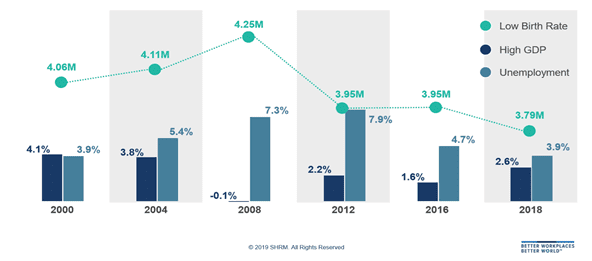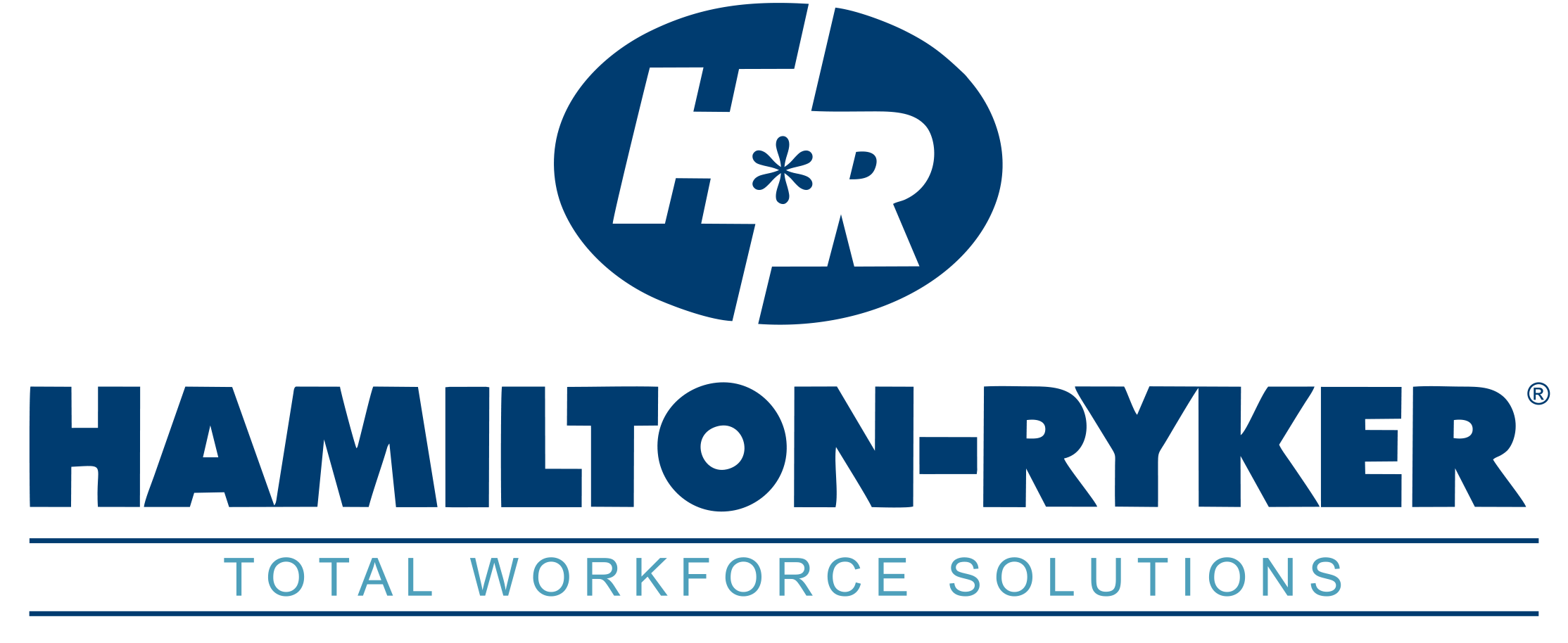Executive Summary from American Staffing Association 2019 Convention
Each year, staffing professionals from across the country gather to discuss workforce trends and evaluate different technologies and strategies. This white paper executive summary covers trends of employment in America today that were presented at the conference. Starting with the evolution of talent within the American workplace and then factoring in the premise that employees are consumers, a clear picture emerges of the reality that it is access to Human Capital that is at the forefront of success for businesses.
America has experienced 109 consecutive months of increased job growth and GDP: however, current statistics indicate we also have one of the lowest birth rates and lowest unemployment records. This has created a talent shortage. In 2017-2018, there were 3.6 million high school graduates and it is forecasted that in 2027-2028, America will have the same number of graduates. This will compound the shortage of the workforce as baby boomers retire.

(Taylor, 2019)
Not only do we have a gap in the number of employees needed, we have a gap of the necessary skills needed for the current and future workplace. The evolution of work has changed from the industrial era to the information era and now to the augmented era. We are now co-working with technology. The workplace has become the IOT, Internet of Things. Robots are being utilized in manufacturing, but employees skilled in programming and maintenance are needed for the robots to function. Skills of employees need to align with this reality.
America’s workplace is at a tipping place where in a few years there will be more millennials and Gen X employees than baby boomers. These employees view the workplace as consumers. They find employment, rate employment, and decide to remain with their employment as they do with the other consumer decisions in their lives. What is the rating of the employer? Does the employer have a purpose that aligns with me? The current “quit rate” is the highest in ten years. Are we as employers considering employees as consumers who make a choice that fits their life goals? As we develop our workforce strategies of recruiting and retention, we need to think like a consumer and act like a marketer.
Some of the current employee consumer trends are:
- Clanning – Are they associating with like-minded people and a brand they believe in?
- Immediacy – Is it easy, personal and immediate?
- Attention Economy – Is the workplace allowing them to live their own way? Can they work from home? Do they get micro-raises?
- Digital Intimacy – The more hyper connected we become, the more humanity we expect from our technology. Does our workplace provide these tools?
- Diversity – Does your workplace attract women, minorities, and workers from non-traditional sources?
Building a robust workforce which has the skills and talents for your current and future needs will be a multi-prong, strategic approach. Companies must provide a purpose and culture that attracts employees. It must then market itself as such and have an “E-presence”. The jobs must provide training of the needed skills and with that training, micro raises of wages and responsibilities.
Recruitment must also come from non-traditional sources, such as people with disabilities, justice -involved and rehabilitation center graduates. These are talent pools and avenues that create a highly loyal workforce based on the investment and opportunity that has been given to them but are oftentimes overlooked because our focus has largely been on those graduating from high school or higher-learning institutions. However, as the Labor Force Participation Rate (LFPR) shows, there are those that are available for work but are not yet working due to barriers to employment and other factors.
The Bureau of Labor Statistics (BLS) reports that the national LFPR is 63% as of October 2019. The labor force participation rate refers to the number of people available for work as a percentage of the total population. More importantly, the BLS does not count everyone who is jobless as unemployed. It excludes those who have not looked for work within the past four weeks. The Bureau also removes them from the labor force. Most people leave the labor force when they retire, go to school, have a disability that keeps them from working, or have family responsibilities. The BLS does not count people who would like to work but aren’t actively looking for work.
The BLS does keep track of those people, though. They are reported in the U-6 unemployment rate. This is at times called the real unemployment rate. It includes those who have looked for work within the past 12 months, but not within the past four weeks. The Bureau calls them “marginally attached to the labor force.” A subset of the marginally attached is called discouraged workers. They have given up looking because they don’t think there are jobs for them. (Amadeo, 2019)
Another popular strategic approach to workforce development is Registered Apprenticeship (RA) programs, which are a great way of growing your own from entry level up to management. There are currently 1500 apprenticeable occupations listed on the US Department of Labor’s website. Occupations range across all industries from healthcare to cyber-security and IT, to manufacturing, logistics and skilled trades. RA programs provide the necessary skills that your workforce needs, assures the knowledge of your current workforce is shared and mentored with an incoming workforce and enforces a healthy culture that your workforce desires. Recruitment and retention increase substantially when a company builds a career pathway with Registered Apprenticeships and develops its workforce with an investment of training and mentoring. And in many cases, there are grants and government funding to subsidize training costs. By utilizing an Apprenticeship Intermediary to provide support services to the apprentices and to manage this process, retention rates further increase.
For more information, please contact Shari Franey, COO, Hamilton-Ryker. sfraney@hamilton-ryker.com
References:
Taylor Jr., Johnny, October 2019. “Shaping Better Workplaces for a Better World”. Staffing World 2019.
Amadeo, K., 2019, June 19. “Unemployment, Its Causes, and Its Consequences.” The Balance. Retrieved from: https://www.thebalance.com/what-is-unemployment-3306222

